Embarking on day trips from Flagstaff Arizona, presents an opportunity to explore the rich tapestry of landscapes, history, and culture that Northern Arizona offers. Nestled within the heart of the Coconino National Forest, Flagstaff serves as a vibrant launching pad for adventures that span from the depths of ancient canyons to the heights of volcanic peaks. Flagstaff itself is a testament to the diverse beauty of the American Southwest. A town steeped in scientific curiosity, home to Lowell Observatory, and the pioneering spirit of Route 66, it stands as a beacon for those who seek to unravel the mysteries of the cosmos or traverse the roads less traveled. However, the true allure of Flagstaff lies in its proximity to natural wonders and historical sites that are uniquely Arizonan, offering a kaleidoscope of experiences that range from the spiritual to the adventurous.
The Grand Canyon, one of the Seven Natural Wonders of the World, is just a short drive away, offering vistas that challenge the limits of perception and stir the soul. The journey there is as much a part of the experience as the destination itself, with each bend in the road revealing panoramas that captivate the imagination and invigorate the spirit. Yet, the Grand Canyon is but the beginning. Sedona’s red rock formations tell tales of the earth’s tumultuous past and present an opportunity for introspection amidst the vortexes, believed by many to be centers of energy that facilitate meditation and healing.
Venturing into the historic heart of Route 66, one can revel in the nostalgia of Americana, discovering diners, motels, and curios that hark back to the golden age of road trips. This historic route serves as a reminder of the journey’s importance, encouraging travelers to embrace the moment and the unexpected discoveries that lie around each corner.
The Petrified Forest National Park and the Painted Desert offer a glimpse into a world frozen in time, where the beauty of ancient, fossilized trees contrasts starkly against a backdrop of vibrant colors that change with the sun’s whims. Similarly, the Navajo Nation and Monument Valley invite explorers to step into landscapes so monumental and serene that they’ve become emblematic of the American West’s indomitable spirit.
As the day wanes, the adventure does not. The ethereal beauty of Antelope Canyon, the verdant expanses of the Coconino National Forest, and the haunting allure of Jerome’s ghost town await. Each destination weaves its own narrative, inviting travelers to immerse themselves in the stories of the land and its people.
From the spiritual to the scenic, the ancient to the artistic, day trips from Flagstaff AZ, offer a spectrum of encounters that enrich the soul and inspire the mind. As we delve deeper into each recommended trip, let us embark with open hearts and an unquenchable thirst for discovery, for it is in these journeys that we often find ourselves.
The Grandeur of the Grand Canyon
Embarking on day trips from Flagstaff to the Grand Canyon is a journey that promises an encounter with one of the most awe-inspiring natural wonders of the world. The Grand Canyon, with its overwhelming size and its intricate and colorful landscape, offers vistas that captivate the imagination and touch the soul. This section aims to guide you through experiencing the Grand Canyon’s grandeur, offering practical advice for planning your visit and making the most of this unparalleled natural wonder.
Flagstaff’s proximity to the Grand Canyon—just a short drive away—makes it an ideal starting point for exploring this magnificent testament to nature’s artistry. The journey itself is a preamble to the canyon’s majesty, winding through forests, past ancient volcanic remnants, and across the plains of the Colorado Plateau. As you approach, the land begins to reveal its secrets, opening up into vast expanses that hint at the grandeur ahead.
The Grand Canyon, carved over millions of years by the Colorado River, stretches over 277 miles, reaching depths of over a mile and widths of up to 18 miles. Its scale is nearly impossible to comprehend until you stand at its edge, peering into the depths where time seems to stand still. The layers of rock tell stories of the earth’s past, with each hue marking a chapter in the planet’s geological history.
Visitors to the Grand Canyon can explore the South Rim, the most accessible and visited section, throughout the year. It offers an array of viewpoints, each presenting a unique perspective of the canyon’s vastness. From Mather Point to Yavapai Observation Station and the historic Grand Canyon Village, the South Rim provides a comprehensive introduction to the canyon’s beauty and scale.
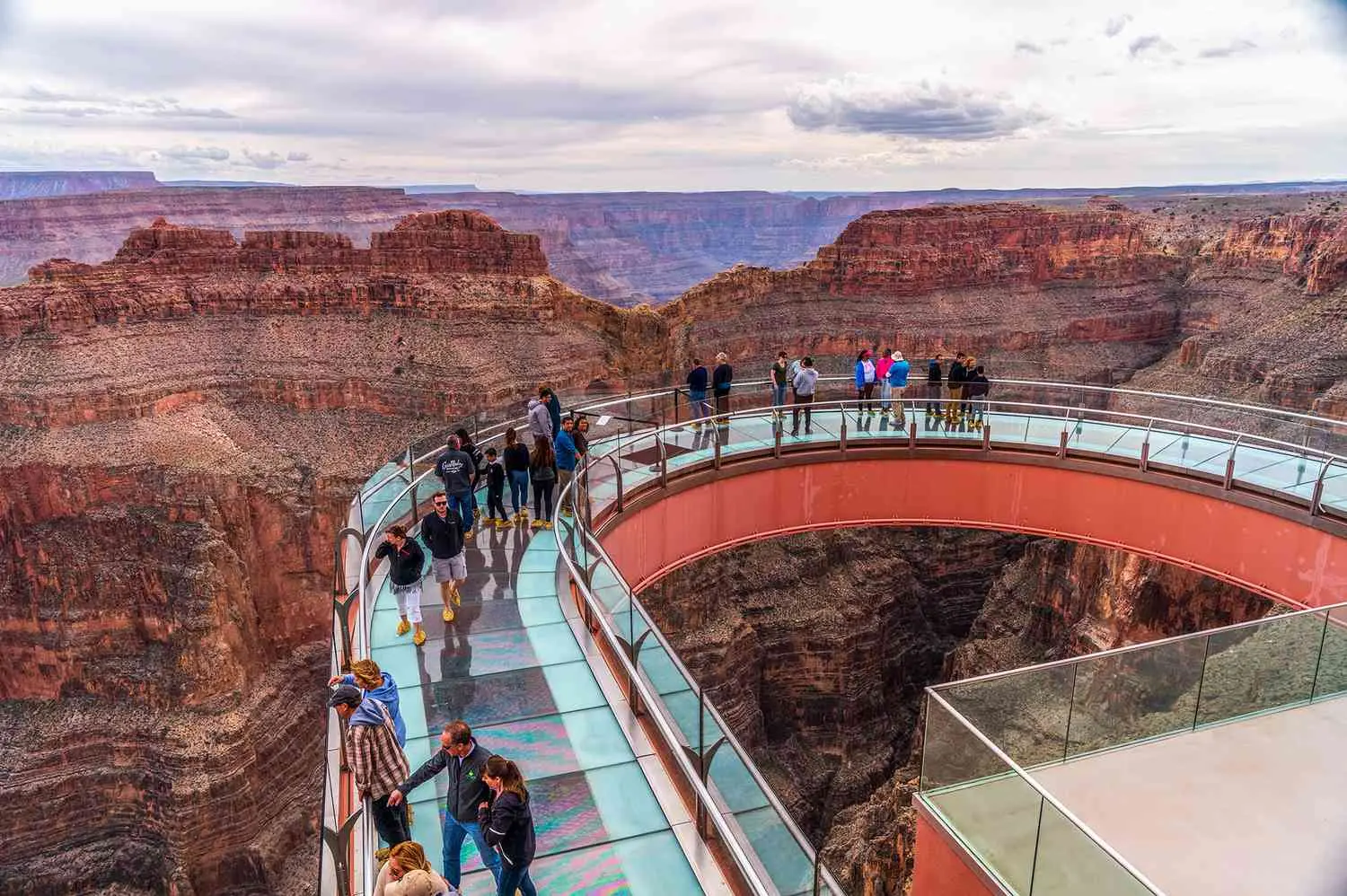
Source: Travel + Leisure
Sedona’s Red Rock Splendor
Located amidst the vermilion-colored rock formations of the Arizona desert lies Sedona, a place where beauty transcends the visual and delves into the spiritual. Day trips from Flagstaff to Sedona is not merely a journey through miles but a passage through different realms of experience. This oasis of natural splendor and serenity offers not just scenic views but also a journey into self-discovery through its famed vortex sites and a myriad of hiking trails that serenade the soul.
Spiritual Journeys and Scenic Views
Sedona’s landscape is a grand tapestry, with each rock formation, each juniper tree, and each winding path telling a story of geological and spiritual significance. The red rocks of Sedona are not only a feast for the eyes but also a catalyst for introspection and spiritual awakening. It is said that the unique energy of Sedona’s vortex sites facilitates meditation, healing, and self-exploration, making it a sanctuary for those seeking spiritual growth.
A vortex is believed to be a special spot on the earth where energy is either entering into the earth or projecting out of the earth’s plane. Sedona is renowned for its powerful vortex sites, each possessing its own unique energy. Visitors come from all over the world to experience the harmonizing effects of these energies, finding peace, balance, and inspiration amidst the awe-inspiring landscapes.
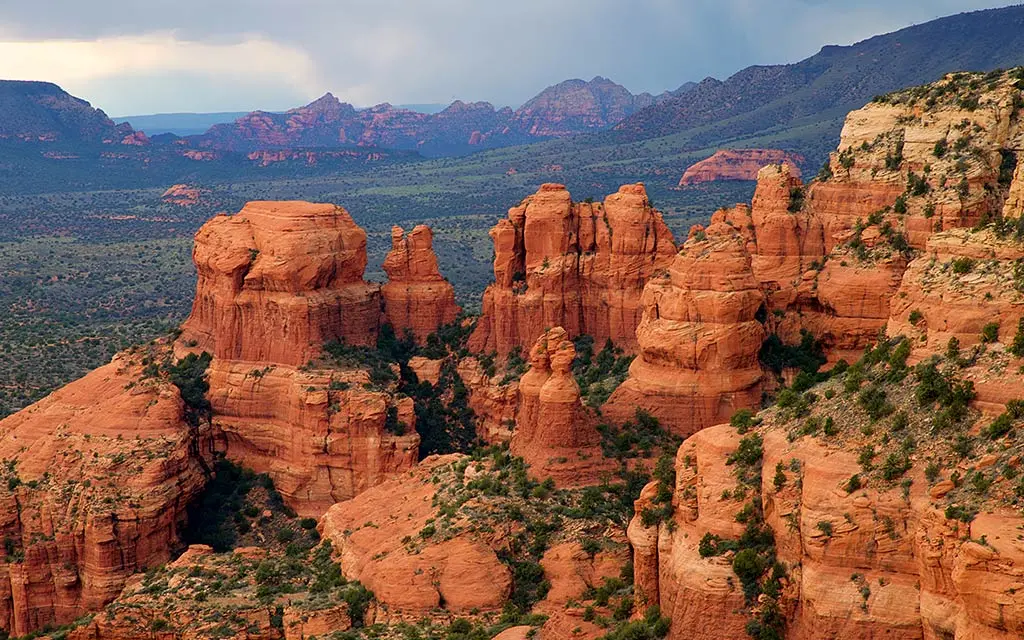
Source: I Love Sedona
Must-Visit Spots: Vortexes and Hiking Trails
Cathedral Rock Vortex
This iconic formation is not just a symbol of Sedona’s natural beauty but also one of its most powerful vortex sites. The journey to Cathedral Rock is a pilgrimage to a place where earth and sky meet, where the energies are said to strengthen one’s inner self and facilitate a deep connection with nature. Hiking the Cathedral Rock Trail offers both a physical challenge and an opportunity for spiritual elevation, culminating in panoramic views that are as breathtaking as the energy felt at the summit.
Bell Rock Vortex
Standing like a sentinel over Sedona, Bell Rock is another vortex site imbued with a strong energy conducive to healing and spiritual awakening. The Bell Rock Pathway offers an accessible route for all ages and skill levels, inviting visitors to immerse themselves in the serene energies and stunning vistas. The journey around Bell Rock is often described as a walk through a living sculpture garden, with each angle presenting a new masterpiece.
In Sedona, the journey is as significant as the destination. It’s a place where the journey of the soul meets the beauty of the landscape, inviting travelers to explore, to reflect, and to connect with the profound energies of the earth.
Exploring the Historic Route 66
Exploring the Historic Route 66, especially the segment that whispers past Flagstaff, Arizona, is akin to taking a trip down memory lane, where each curve in the road and each landmark tells a story of America’s bygone era of road travel. This storied highway, affectionately known as the “Mother Road,” once ferried travelers across the heartland of America, from Chicago to Santa Monica, offering a path to the promises of the West. Today, a journey along Route 66 from Flagstaff offers not only a nostalgic trip through Americana but also an exploration of historic sites, quirky roadside attractions, and breathtaking landscapes that have captured the imagination of travelers for decades.
A Trip Down Memory Lane
The portion of Route 66 that winds its way through Northern Arizona, and specifically Flagstaff, is a testament to the road’s enduring legacy. Established in 1926, Route 66 served as a major path for those migrating west, especially during the Dust Bowl of the 1930s. It was the backdrop for John Steinbeck’s “The Grapes of Wrath,” and it inspired a hit song and a television show, cementing its place in American cultural lore. The decommissioning of the route in 1985 in favor of the Interstate Highway System could not erase its impact, and today, it enjoys a renaissance as both a historic journey and a symbol of freedom, adventure, and discovery.
Flagstaff stands as a proud custodian of Route 66 heritage, with its downtown area offering a glimpse into the road’s golden age. Vintage neon signs, historic buildings, and local diners offer a slice of mid-20th-century Americana, inviting travelers to step back in time and experience the allure of the open road as it once was.
The Petrified Forest National Park
The Petrified Forest National Park, located in Northeastern Arizona, offers a journey back in time to an era when the earth was young and dinosaurs roamed freely. This unique landscape, where the remnants of ancient forests have turned to stone, presents an otherworldly experience that captivates the imagination of all who visit. Day trips from Flagstaff to the Petrified Forest is not merely a travel in distance but a voyage across epochs, where the land tells tales of geological marvels and the transient nature of existence.
Entering the Petrified Forest National Park, one is immediately struck by the surreal beauty of its landscape. Here, the remains of giant trees that fell millions of years ago lie scattered across a stark, colorful badlands terrain. These petrified logs, now stone, shimmer with the vibrant colors of minerals like quartz, amethyst, and jasper, which have replaced the organic material of the wood in a process called permineralization. The result is a forest frozen in time, where each petrified log tells a story of ancient life and the slow, inexorable forces of nature.
The park spans over 200,000 acres, encompassing both the Rainbow Forest, renowned for its high concentration of petrified wood, and the Painted Desert, a vast landscape of stunningly colored badlands. Hiking trails, such as the Giant Logs Trail near the Rainbow Forest Museum, offer visitors an intimate view of these ancient relics. The Crystal Forest Trail, another popular path, winds through landscapes littered with brilliantly colored petrified wood, providing a tangible connection to the deep past.
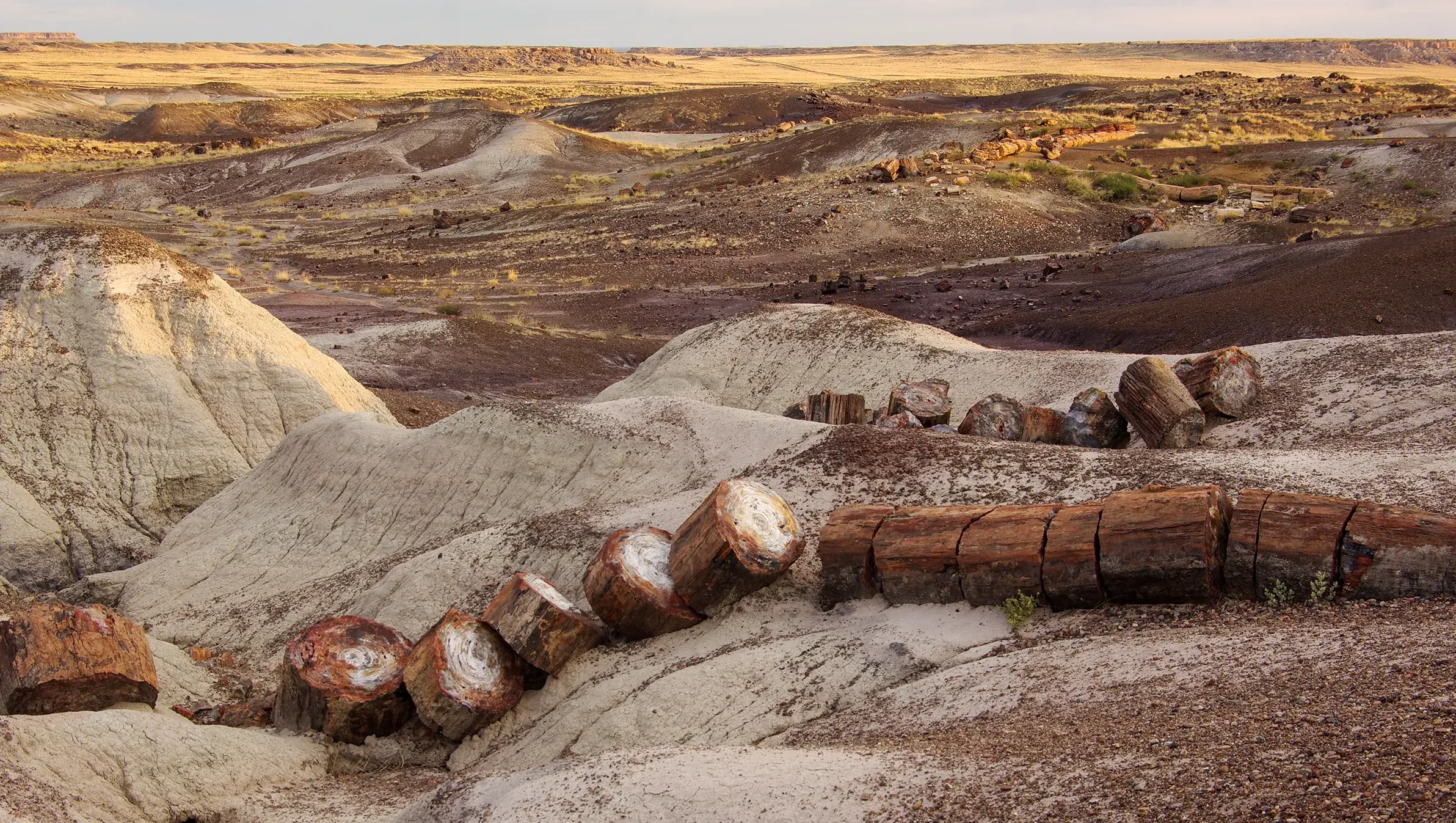
Source: USA Today
The Petrified Forest is not only about the remnants of ancient trees; it is a testament to the ever-changing earth. The park’s geology reveals layers of sedimentary rock that chronicle Earth’s history over millions of years. The Tepees area showcases eroded hills of blue, purple, and gray, offering a vivid example of the forces that have shaped this land. Additionally, the park is home to significant archaeological sites, including petroglyphs carved into the rocks by early inhabitants, adding a human element to the ancient story of this place.
Photographing the Petrified Forest is a privilege, a chance to capture a moment in the continuum of geological time. The park’s landscapes challenge photographers to convey the essence of this ancient place, where every stone tells a story of deep time, and every vista opens a window to the past.
Navajo Nation and Monument Valley
A journey into the Navajo Nation and Monument Valley from Flagstaff, Arizona, transcends a mere day trip; it’s an immersive dive into a rich tapestry of Indigenous culture, history, and some of the most iconic landscapes in the United States. This exploration offers a profound connection to the land and its people, revealing the deep spiritual significance these places hold. As visitors traverse this sacred land, it is essential to approach with respect, seeking not just to see but to understand and appreciate the Navajo way of life and the natural wonders that define Monument Valley.
The Navajo Nation, the largest Native American territory in the United States, presents an opportunity for visitors to engage with a culture steeped in tradition, art, and a profound connection to the earth. Monument Valley, within the Navajo Nation, is a testament to the raw beauty and spiritual power of the landscape. Its towering sandstone buttes, some reaching over 1,000 feet above the valley floor, have become symbols of the American West, immortalized in countless films and photographs. Yet, to the Navajo people, these formations are more than just scenic vistas; they are sacred spaces that tell the stories of their ancestors and the creation of the earth.

Source: DETOURS American West
The cultural immersion extends beyond the landscapes to the art and craftsmanship of the Navajo people. Visitors have the opportunity to see and purchase traditional Navajo jewelry, weavings, and pottery, each piece a reflection of the artist’s connection to their culture and the natural world. Through these interactions, visitors gain a deeper appreciation for the craftsmanship and the stories embedded in each piece.
Embracing the Navajo Nation and Monument Valley
A visit to the Navajo Nation and Monument Valley is a journey into the heart of landscapes that have shaped the cultural identity of the Navajo people and the American West. These places invite introspection and a deeper connection to the natural world, offering lessons in resilience, beauty, and the sacredness of the land.
Monument Valley, with its majestic buttes and sweeping vistas, embodies the untamed spirit of the West yet reminds us of the intricate balance between humans and the natural environment. The Navajo Nation, with its rich cultural heritage and enduring traditions, offers a window into a way of life deeply rooted in the earth and the ancestors’ teachings.
Antelope Canyon’s Natural Marvels
Antelope Canyon, a sculptural masterpiece carved by the hands of nature, stands as one of the most mesmerizing and photographed slot canyons in the world. Located within the heart of the Navajo Nation in Northern Arizona, near the town of Page, this natural wonder is a testament to the power and beauty of natural forces. A visit to Antelope Canyon is not just a journey through a physical space but a voyage into a realm of light, shadow, and color, where the boundaries between the earthly and the ethereal seem to blur. This sacred site, revered by the Navajo people, offers an unparalleled experience of immersion into the natural world’s artistry.
The Marvels of Antelope Canyon
Antelope Canyon is divided into two distinct sections, known as Upper Antelope Canyon or “The Crack” and Lower Antelope Canyon or “The Corkscrew.” Each section offers a unique experience, yet both are characterized by their winding corridors, soaring sandstone walls, and the ethereal light beams that penetrate the narrow openings above, creating a dance of light and shadow that changes with the time of day and season.
Upper Antelope Canyon is renowned for its accessible, ground-level entrance and the breathtaking light beams that occur around midday during the summer months. Walking through Upper Antelope Canyon is like moving through a living sculpture, where the smooth, flowing walls reflect hues of orange, red, purple, and gold. The play of light and shadow, combined with the natural contours of the stone, creates a surreal landscape that feels otherworldly.
Lower Antelope Canyon, on the other hand, offers a more adventurous visit. Accessed by a series of staircases, the descent into Lower Antelope Canyon reveals a narrower, more twisting path than its counterpart. This section is celebrated for its intricate rock formations, angular walls, and the dynamic interplay of light throughout the day. The journey through Lower Antelope Canyon is a more physical experience, requiring visitors to navigate its curves and ladders, but it rewards with a profound sense of discovery and connection to the earth.
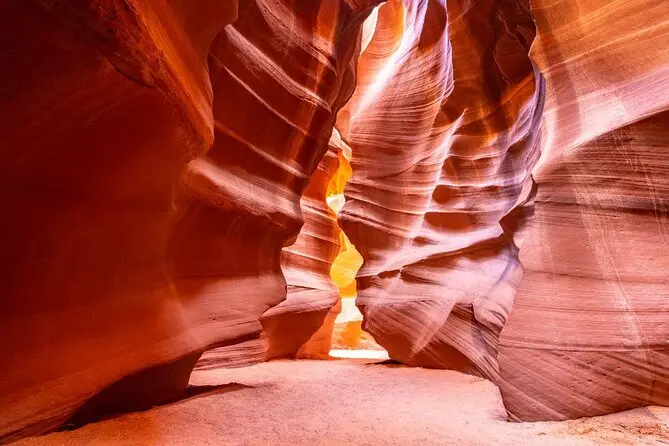
Source: Viator
The Ethereal Experience of Antelope Canyon
Antelope Canyon stands as a monument to the artistic power of nature, a place where the elements have conspired to create a landscape that defies imagination. Its corridors tell the story of time itself, carved by water and wind into forms and textures that speak to the impermanence and beauty of the natural world.
In the silence of the canyons, amidst the dance of light and shadow, visitors find not just beauty but a deeper understanding of the world around them. Antelope Canyon, with its ethereal landscapes, serves as a bridge between the tangible and the spiritual, offering a moment of reflection on our place in the universe and the transient nature of our existence. It’s a place where every curve, every ray of light, tells a story of creation, erosion, and the enduring allure of the natural world.
The Coconino National Forest
The Coconino National Forest, encompassing over 1.8 million acres of diverse landscapes across Northern Arizona, stands as a testament to the natural world’s vast beauty and complexity. From the towering peaks of the San Francisco Mountains to the red rock vistas of Sedona, this protected area offers a gateway to a plethora of outdoor adventures that cater to nature lovers of all kinds.This journey into the Coconino National Forest reveals not just the opportunities for adventure but also the importance of conservation and the simple joy of connecting with nature.
The Coconino National Forest is not just a single landscape but a mosaic of terrains, each with its unique allure. The forest is divided into three distinct districts: the Flagstaff District, with its high-altitude forests and volcanic peaks; the Red Rock District, where the famous red sandstone formations of Sedona enchant visitors; and the Mogollon Rim District, a dramatic escarpment that offers breathtaking views and a cooler refuge during the hot summer months.
Springtime is marked by the blooming of wildflowers and the melting of snow, revealing fresh streams and verdant meadows. Summer offers a respite from the desert heat, with cool breezes in the high country and the chance to swim in natural pools and creeks in Sedona. Autumn paints the landscape in vibrant hues of gold, orange, and red, particularly in the aspen groves of the San Francisco Peaks, while winter covers the landscape in a blanket of snow, creating a serene and peaceful wilderness.
The forest is home to a diverse array of animals, including elk, deer, black bears, and numerous species of birds. The Mexican spotted owl, a threatened species, finds refuge in the forest’s canyons, while bald eagles can be seen soaring over the lakes and rivers. Even the elusive mountain lion roams the forest’s more remote areas, a reminder of the wildness that still exists within these protected lands.
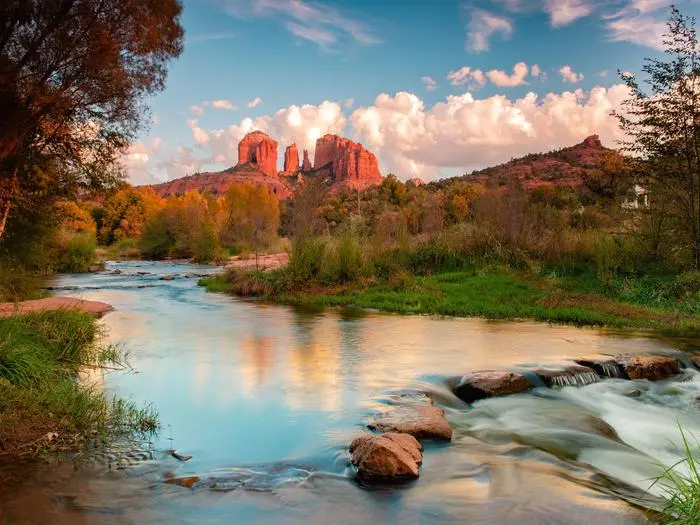
Source: Recreation.gov
Jerome: A Hauntingly Beautiful Ghost Town
Perched precariously on the steep slopes of Cleopatra Hill, overlooking the vast Verde Valley, Jerome, Arizona, is a town that embodies the spirit of the Wild West like no other. Once a thriving copper mining camp, boasting a population of nearly 15,000 at its peak, it now stands as a hauntingly beautiful ghost town, a testament to the boom-and-bust cycle of mining life. However, Jerome is far from abandoned. Today, it thrives as an artistic community, its historic buildings now home to galleries, boutiques, and cafes, all while retaining the allure of its storied past.
Jerome’s establishment in the late 19th century was driven by the discovery of rich copper deposits. The town quickly grew into a bustling mining community, characterized by its diverse population, including miners from around the world, and a reputation for lawlessness. The Douglas Mansion, built by a mining magnate, and the Audrey Headframe Park, with its historic mining equipment, offer glimpses into Jerome’s prosperous era and the lives of those who toiled underground.
The transformation of Jerome from a mining ghost town to a vibrant artistic community is a story of resilience and creativity. Artists and craftspeople, drawn by the town’s dramatic setting and the allure of its abandoned buildings, began to settle in Jerome in the 1960s and 70s. Today, Jerome’s winding, hilly streets are lined with galleries and studios showcasing a wide array of art, from paintings and photography to handmade jewelry and glassworks. The Jerome Art Walk, held on the first Saturday of each month, exemplifies this blend of history and creativity, as visitors and locals alike explore the galleries, often housed in historic buildings, enjoying the work of local artists while soaking in the atmospheric charm of the town. The spirit of community among the artists is palpable, and many are happy to share stories of their work and the town’s history, offering a personal insight into Jerome’s unique culture.
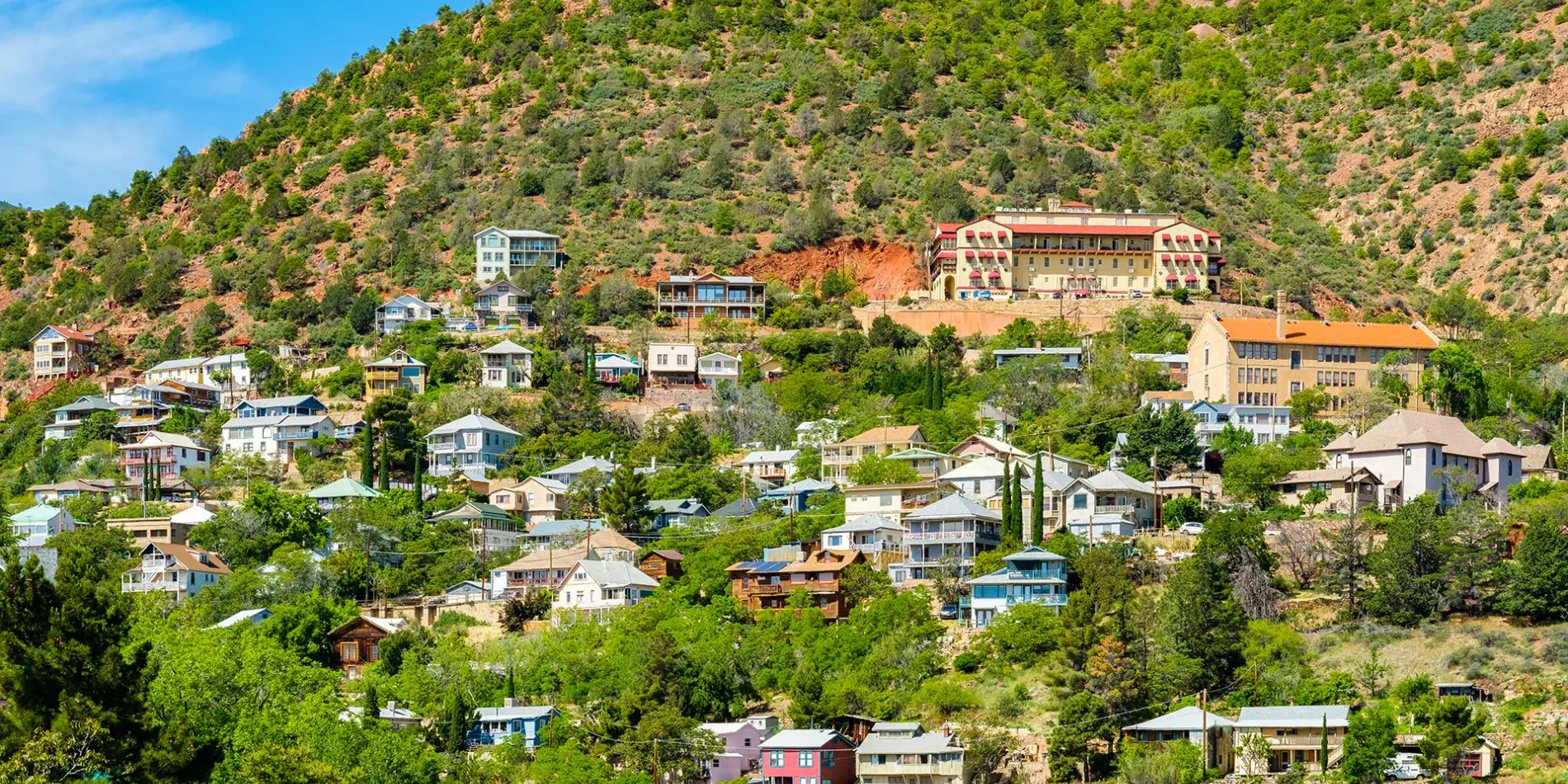
Source: Visit Arizona
Embracing the Spirit of Jerome
Visiting Jerome is an experience that transcends the ordinary. It’s a journey through time, where every building, street, and artifact tells a story of boom and bust, of hardship and hope. It’s a place where the past is not hidden away but embraced and woven into the fabric of daily life, creating a town that is both a historical monument and a living, breathing community.
The beauty of Jerome lies not just in its physical setting but in the stories that permeate its very walls. The miners, the artists, the spirits said to roam its streets—all contribute to the tapestry of tales that make Jerome an unforgettable destination.
Montezuma Castle National Monument
Montezuma Castle National Monument, settled into the limestone cliffs of Arizona’s Verde Valley, stands as a magnificent testament to the ingenuity and resilience of the ancient Sinagua people. This five-story, 20-room dwelling, built into a recess in the cliff approximately 100 feet above the ground, was constructed over 600 years ago. It offers a window into the lives of the Sinagua, who flourished in this region from approximately 1100 to 1425 A.D. Today, Montezuma Castle invites visitors from around the globe to marvel at one of the best-preserved cliff dwellings in North America, providing a tangible connection to the prehistoric past and the legacy of the Sinagua culture.
Prehistoric Dwellings and the Legacy of the Sinagua
The Sinagua, a name derived from the Spanish words “sin agua,” meaning “without water,” were an ancient people who mastered the art of living in a region with limited water resources. They were farmers, hunters, and gatherers who utilized the land efficiently, growing crops such as corn, beans, and squash in the fertile floodplain of Beaver Creek. The construction of Montezuma Castle, using natural alcoves in the limestone cliffs for protection against elements and enemies, showcases their architectural sophistication and understanding of their environment.
The structure’s strategic location not only provided defense but also moderated temperature, keeping it cool in summer and warm in winter. The Sinagua’s skill in masonry is evident in the intricate construction of the dwelling, which has stood the test of time, enduring for centuries as a symbol of their legacy.
The Verde Valley, home to Montezuma Castle, is rich in archaeological sites and natural beauty, making it an area ripe for exploration beyond the national monument.
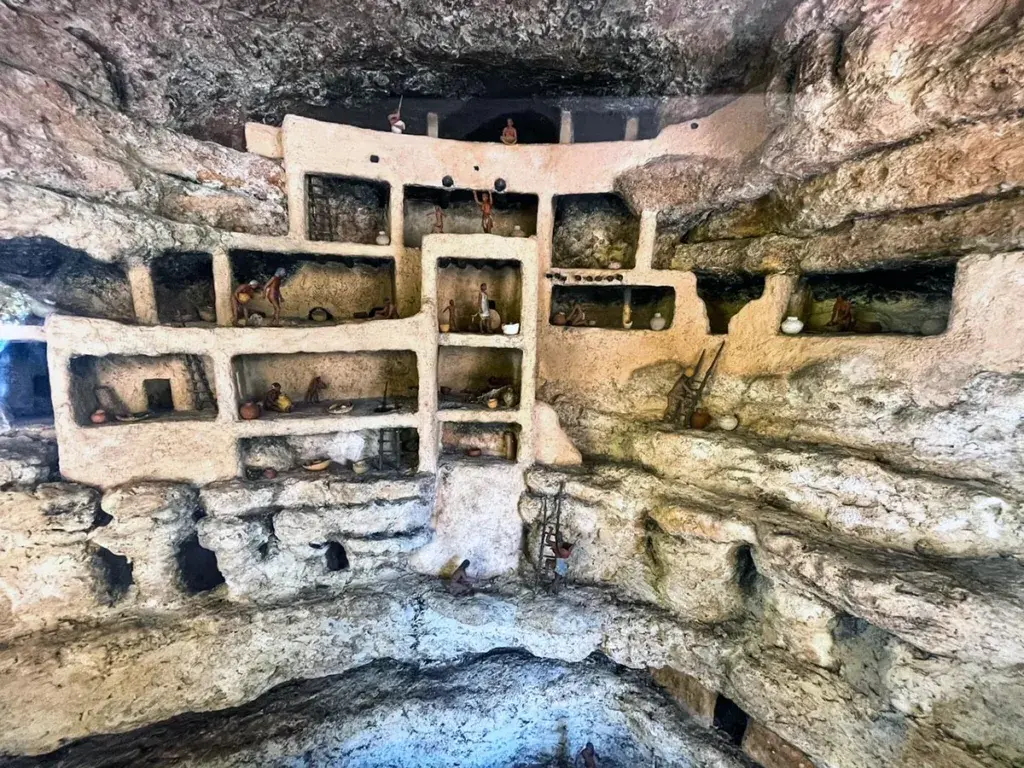
Source: Beyond My Door
Montezuma Well
Just a short drive from Montezuma Castle, Montezuma Well is a natural limestone sinkhole producing over a million gallons of water each day. This unique aquatic ecosystem was used by the Sinagua for irrigation, and visitors can see the remnants of their ancient irrigation ditches. Trails around the well offer views of the water, additional cliff dwellings, and ancient pit houses.
Verde Canyon Railroad
The railroad winds through canyons, over trestles, and past ancient ruins, offering a relaxing way to appreciate the area’s scenic wonders.
Tuzigoot National Monument
Tuzigoot National Monument, located atop a limestone and sandstone ridge overlooking the verdant Verde Valley in central Arizona, stands as a silent witness to the ingenuity and resilience of the ancient Sinagua people. This sprawling pueblo, which translates to “crooked water” in Apache, consists of over 100 rooms built by the Sinagua, who inhabited this region from roughly 1000 to 1400 A.D. Today, Tuzigoot offers visitors the rare opportunity to walk among the remnants of this prehistoric culture, exploring the complexity of their community life, their agricultural practices, and their profound connection to the land.
Exploring Ancient Pueblos
The journey through Tuzigoot National Monument is a step back in time. The main structure, a two-to-three-story pueblo, sits majestically on the summit of the ridge, commanding expansive views of the Verde River and the lush valley below. This strategic location provided the Sinagua with a vantage point for defense and a prime spot for observing the stars and the changing seasons, which were integral to their agricultural calendar.
The Tuzigoot Museum, located near the entrance, houses an impressive collection of artifacts recovered from the site, including pottery, stone tools, and jewelry, offering further insights into the Sinagua culture. The exhibits tell the story of a people adept at adapting to their environment, skilled in the arts of pottery and weaving, and deeply spiritual, as evidenced by the artifacts believed to be used in religious ceremonies.
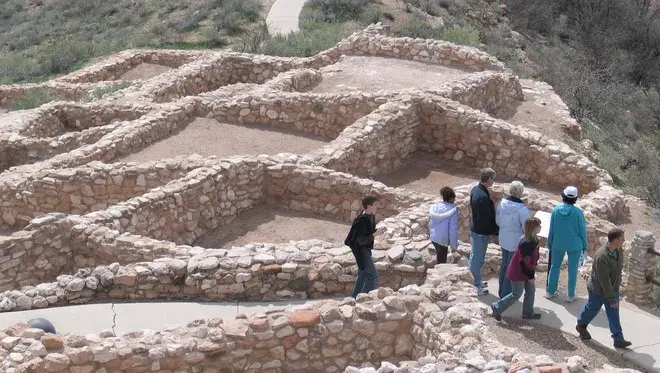
Source: AZCentral
Bird Watching and Nature Trails
Tuzigoot National Monument is not only a place of historical and cultural significance but also a haven for wildlife enthusiasts. The monument is part of the Tavasci Marsh, one of the largest freshwater marshes in Arizona. This lush, riparian area provides critical habitat for a wide variety of bird species, making Tuzigoot a popular destination for bird watching. Visitors can spot a diverse array of birds throughout the year, including the vibrant Vermilion Flycatcher, the elusive Yellow Warbler, and the majestic Bald Eagle. The marsh also supports other wildlife, including beavers, otters, and a variety of reptiles and amphibians.
The Tavasci Marsh Trail offers a peaceful walk through this rich ecosystem, allowing visitors to immerse themselves in the natural beauty of the area. The trail provides several viewing platforms from which to observe the marsh’s inhabitants and take in the serene landscape. This blending of cultural exploration with nature observation underscores the Sinagua’s deep connection to their environment, a relationship that sustained them for centuries.
Embracing the Legacy of Tuzigoot
Walking through the ancient pueblo, overlooking the same landscape once gazed upon by the Sinagua, visitors are reminded of the continuity of human history and our ongoing relationship with the natural world. The monument serves as a bridge between the past and present, offering lessons in sustainability, resilience, and the importance of understanding our ancestors’ lives.
In the heart of Arizona’s Verde Valley, Tuzigoot National Monument offers a unique blend of ancient history, cultural insight, and natural beauty. It is a place where the past is palpable, inviting visitors to explore the remnants of a once-thriving pueblo, to reflect on the lives of its inhabitants, and to enjoy the abundant natural beauty that surrounds it. Through its ancient ruins, museum exhibits, and nature trails, Tuzigoot continues to teach, inspire, and awe, bridging centuries and connecting us to the enduring human spirit.
Lake Powell: A Desert Oasis
Lake Powell, a man-made reservoir on the Colorado River, straddling the border between Utah and Arizona, is a marvel of natural beauty and human ingenuity. Created by the damming of the Colorado River with the completion of the Glen Canyon Dam in 1963, Lake Powell has since transformed into a desert oasis, drawing visitors from around the globe. Its crystal-clear waters, set against a backdrop of towering red rock canyons and sprawling desert landscapes, offer a paradise for water sports enthusiasts, anglers, and those seeking a serene retreat from the hustle and bustle of daily life. This vast, shimmering expanse of water is not just a hub of recreational activity; it’s a sanctuary where the rugged beauty of the desert meets the soothing tranquility of the lake.
For adventure seekers and outdoor enthusiasts, Lake Powell is a playground without equal. The lake’s expansive waters, stretching over 186 miles, provide the perfect setting for a variety of water sports, from wakeboarding and waterskiing to kayaking and paddleboarding. The calm mornings are ideal for smooth rides across the water, while the afternoons offer stronger breezes suitable for sailing adventures.
Boating is a popular way to explore Lake Powell, with numerous hidden coves and secluded beaches accessible only by water. Houseboat rentals offer a unique way to experience the lake, allowing visitors to wake up to waterfront views in a new location each day. These floating homes provide all the comforts one could need, from fully equipped kitchens to rooftop decks, making them a popular choice for families and groups seeking both adventure and relaxation.
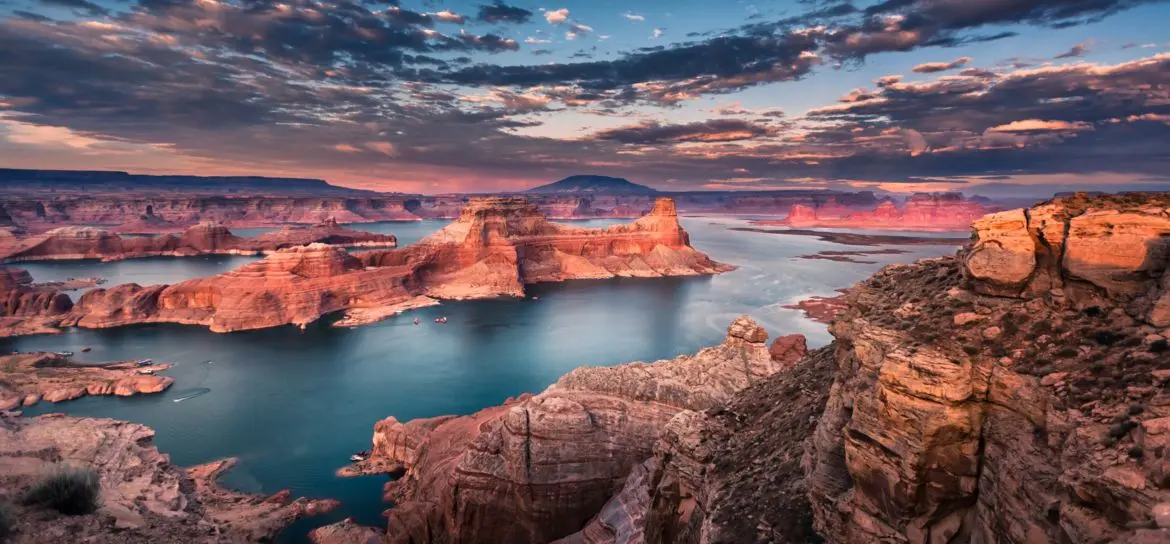
Source: Papillon Helicopters
Scenic Cruises and Fishing Spots
Lake Powell’s vast size and intricate shoreline make it a prime destination for scenic cruises. Guided tours are available, taking visitors on a journey through the lake’s most breathtaking landscapes, including the iconic Rainbow Bridge National Monument, one of the world’s largest natural arches. These cruises provide not only stunning views but also the opportunity to learn about the area’s geology, history, and the rich cultural heritage of the Navajo Nation, which borders the lake.
Fishing enthusiasts will find Lake Powell to be an angler’s dream. The lake is home to a diverse array of fish species, including bass, catfish, and walleye, making it a popular destination for both novice and experienced fishermen.
Preserving Lake Powell’s Natural Beauty
As a testament to human ingenuity and natural splendor, Lake Powell also serves as a reminder of the importance of environmental stewardship. The creation of the lake has had significant ecological impacts, altering the landscape and affecting local ecosystems. Visitors are encouraged to practice responsible tourism, adhering to Leave No Trace principles to minimize their impact on the environment. This includes proper waste disposal, respecting wildlife, and being mindful of water usage.
The fluctuating water levels of Lake Powell, influenced by drought and water demand, highlight the challenges of water management in the arid Southwest. These changes not only affect recreational activities but also serve as a stark reminder of the region’s vulnerability to climate change. By promoting conservation efforts and sustainable tourism practices, we can help ensure that Lake Powell remains a cherished destination for future generations.
Embracing the Desert Oasis
Lake Powell’s allure lies in its ability to offer both exhilarating adventures and moments of serene contemplation. It is a place where the stark beauty of the desert landscape meets the soothing embrace of the water, creating a unique environment that captivates the heart and refreshes the spirit.
In a world that often moves too fast, Lake Powell serves as a sanctuary, a place to slow down, recharge, and reconnect with the natural world. It stands as a testament to the beauty that can arise at the intersection of nature and human creativity, inviting all who visit to embrace the joy and wonder of this desert oasis.
The Chocolate Falls (Grand Falls)
The Chocolate Falls, more formally known as Grand Falls, is a spectacular natural wonder hidden within the arid landscapes of the Navajo Nation, near Flagstaff, Arizona. These falls, often likened to a chocolate version of Niagara due to the muddy waters of the Little Colorado River, present an astonishing contrast to the surrounding desert terrain. Standing at an impressive 185 feet, Grand Falls actually surpasses the height of its more famous counterpart, Niagara Falls, making it a captivating destination for those seeking the unique beauty that nature has to offer. The phenomenon of the falls, particularly during the peak flow periods, is a testament to the desert’s ability to surprise and awe, revealing the hidden vibrancy and dynamism of its landscapes.
The most striking feature of Grand Falls is its seasonal nature, with the falls coming alive in the late winter and early spring. This is when the snowmelt from the mountains flows into the Little Colorado River, transforming the ordinarily tranquil stream into a powerful torrent that cascades over the cliffs, creating the chocolate-colored falls. This period also coincides with the desert beginning to bloom, as the increased moisture awakens the dormant seeds of wildflowers, dotting the landscape with bursts of color.
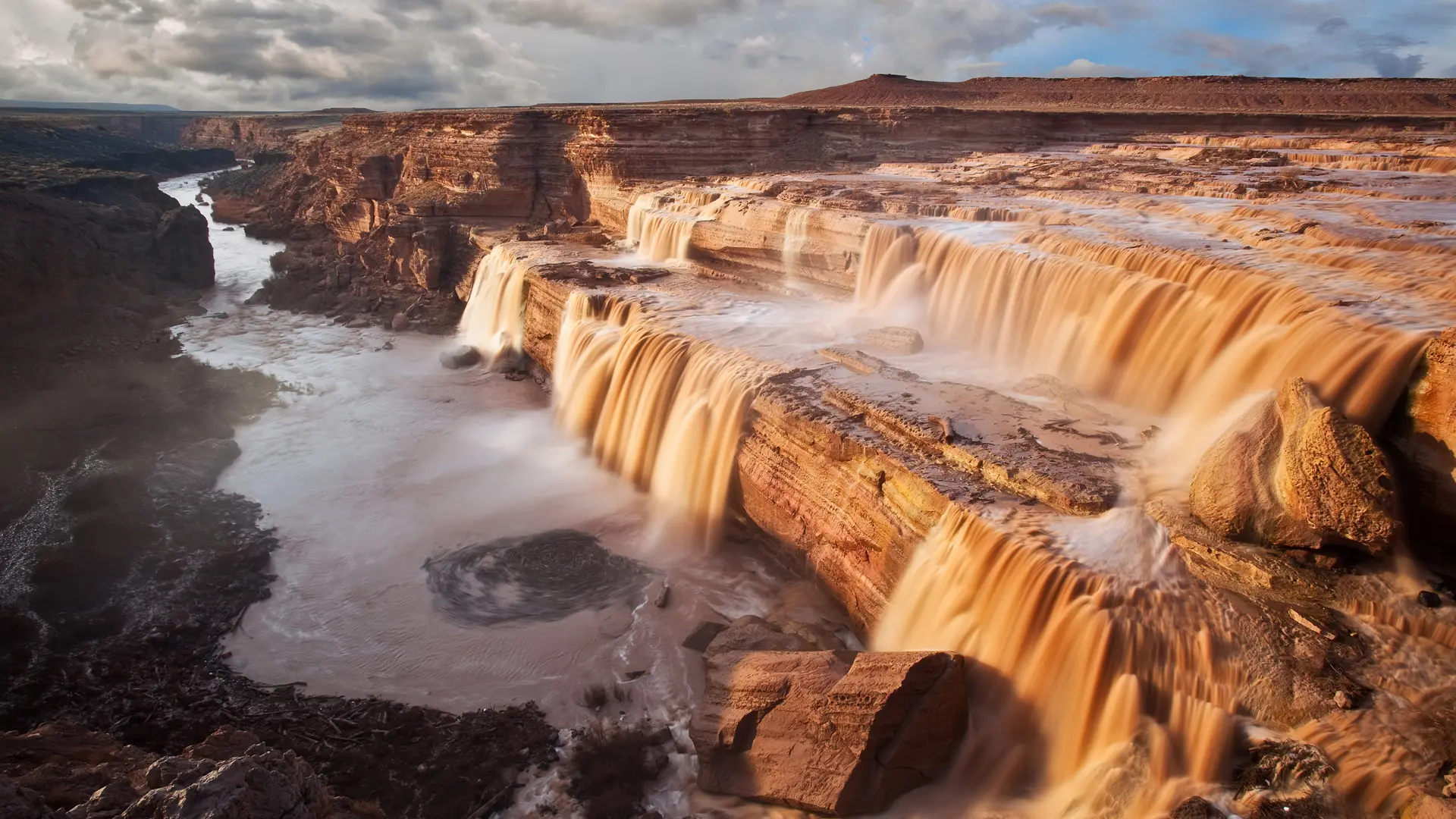
Source: Flagstaff, AZ
Embracing the Spectacle of the Chocolate Falls
Grand Falls offers a unique opportunity to witness the transformative power of water in the desert, a spectacle that challenges the stereotypical image of arid landscapes as lifeless and unchanging. This natural wonder, coupled with the seasonal bloom of the desert, provides a profound reminder of the cycles of nature and the hidden beauty waiting to be discovered in the most unexpected places.
Visiting the Chocolate Falls is an experience that resonates deeply with those who witness it, offering a moment of reflection on the majesty of the natural world and our place within it. It’s a destination that not only showcases the dramatic beauty of the Arizona desert but also highlights the importance of preserving these natural wonders for the awe and inspiration of future generations.
Day Trips from Flagstaff Arizona: Final Thoughts
In conclusion, day trips from Flagstaff, Arizona, offer an unparalleled opportunity to explore the diverse landscapes and rich cultural heritage of the region. Whether you’re seeking the awe-inspiring vistas of the Grand Canyon, the intriguing ancient cliff dwellings of Walnut Canyon, the volcanic landscapes of Sunset Crater, or the serene beauty of Sedona’s red rocks, there’s something for every type of traveler. These destinations not only provide breathtaking natural scenery but also offer a chance to delve into the history and culture of the American Southwest. Moreover, Flagstaff itself, with its charming downtown and vibrant community, serves as the perfect starting point for these adventures. Overall, embarking on day trips from Flagstaff, Arizona, is a journey through the heart of the Southwest’s beauty and history, ensuring memories that will last a lifetime.



